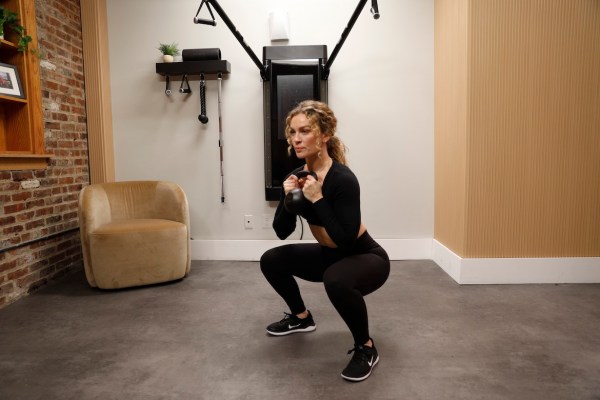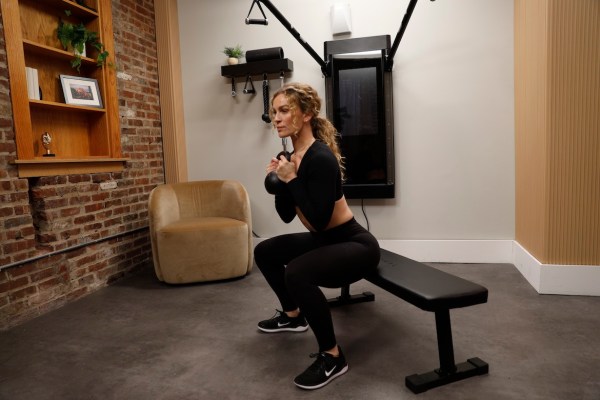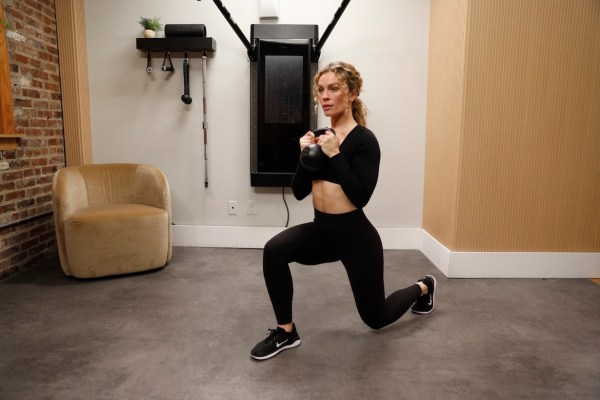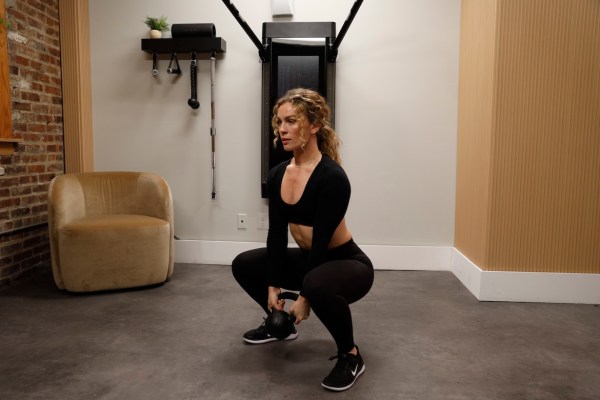The goblet squat doesn’t just have a cool name, it is also one of the most effective ways to strengthen your legs, lift your butt, and even increase lower-body flexibility. Named because you squat while holding a kettlebell or dumbbell in front of you like a goblet, this move truly benefits everyone.
In addition to the lower-body strengthening benefits of squats, this exercise has additional perks. “The front-racked nature of the goblet squat challenges the core to engage, providing stability and support for the spine,” says Kendall Wood, CPT, certified personal trainer and Tonal coach. “The upper back is also called in to join the party, with slight retraction at the shoulder blades improving posture and providing support for the external load.”
Before you grab a weight and start squatting, there are a few important things to know. “Proper form, appropriate weight selection, and balanced training frequency are key to maximizing their benefits while minimizing risks,” says Joey Thurman, CPT, certified personal trainer, author, and founder of Fun Fitness Bros.
So, let’s dive into everything you need to know about goblet squat muscles worked, how to do one with perfect form every time, variations, safety tips, and more.
How to do a goblet squat with proper form
There are several variations of the goblet squat (more on those below), however it’s important to nail the form of the traditional goblet squat first. You’ll need a dumbbell, kettlebell, or medicine ball for this move.

- Stand with your feet shoulder-width apart, your toes slightly pointed out.
- Hold weight in front of your chest. (If using a kettlebell or dumbbell, hold it in a vertical position.)
- Your elbows should be tucked into your sides, not flaring out.
- Keeping your chest up and core engaged, sit your hips back and bend your knees to lower into a squat.
- Continue lowering yourself down until your thighs are parallel to the ground (or as close as you can comfortably go without pain and maintaining proper form).
- Squeeze your glutes, push through your heels, and return to a standing position.
- Repeat for 2 to 3 sets of 8 to 12 reps.
Goblet squat muscles worked
Goblet squats primarily work your quads and glutes, according to the National Academy of Sports Medicine (NASM). But because you’re holding a weight, this move also strengthens your core and upper body.
“The goblet squat is a highly effective lower-body exercise that targets the quadriceps, hamstrings, glutes, and core—with additional benefits for mobility and balance,” Thurman says.
The goblet squat will strengthen and tone the muscles in your legs, including your calves. Holding the weight at chest height brings in your upper body, including your lats, upper-back muscles, and biceps. It even improves your grip strength.
Your core, including your abdominals and postural muscles, also kick in to keep your trunk upright against the front weight.
“It requires minimal equipment—a dumbbell or kettlebell—and can be performed in a variety of settings, making it accessible to a wide range of individuals.” —Joey Thurman, CPT
Goblet squat benefits that’ll convince you to give it a try
The goblet squat has all the benefits of squats, with an added upper-body and core component. Let’s jump into specifics.
1. It increases total-body strength
The goblet squat lifts and tones your glutes, strengthens your legs (quads, hamstrings, and calves), and works your core. Holding a weight brings in your upper body, including your arms, shoulders, and back.
This one move gives you all the benefits of resistance training, which includes increasing lean muscle mass, improving metabolism, boosting bone density, and improving cardiovascular health, per a notable July 2012 research article in Current Sports Medicine Reports.
2. It improves core strength
Holding a weight in front of your chest does more than just strengthen your arms and shoulders. It engages your core muscles, too, in order to maintain an upright posture, according to Thurman. This leads to an improvement in core strength and stability, he says.
3. It’s beneficial for people who have back pain
Because you’re holding a weight in front of you versus behind you, it allows you to add resistance without putting the load or force on your back, according to a January 2022 research article in Orthopedics and Sports Medicine.
This is beneficial to those who want to add some added weight with their squats, but don’t want to stress their back.
4. It increases mobility and flexibility
The squatting motion improves the flexibility of your muscles and the mobility of your joints. “Holding the weight in front of the chest encourages deeper squat depth, promoting improved hip, knee, and ankle mobility,” Thurman says.
5. It’s accessible and functional
“The squat is one of our most functional movements, in that we perform squats in various ways in daily life, and most of the time, it’s subconscious,” Wood says. “Though we’re generally comfortable with this movement pattern, adding external load introduces new challenges.”
It is also an exercise that can be done anywhere.
“It requires minimal equipment—a dumbbell or kettlebell—and can be performed in a variety of settings, making it accessible to a wide range of individuals,” Thurman says.
Goblet squat variations to mix things up
Whether you need a goblet squat modification or are ready to kick it up a notch and further challenge your muscles, there’s a goblet squat variation for you.
1. Goblet box squat
Whether you are recovering from an injury or don’t quite have the strength to maintain proper form with the regular goblet squat, the goblet box squat is a great starting point.
For this exercise, you’ll need a box, chair, or bench. In general, it should be slightly higher than knee height. However, if your legs need more support, you can start with a higher box.

- Stand with your feet shoulder-width apart, your toes slightly pointed out.
- Hold weight in front of your chest. (If using a kettlebell or dumbbell, hold it in a vertical position.)
- Your elbows should be tucked into your sides, not flaring out.
- Keeping your chest up and core engaged, sit your hips back and bend your knees to lower into a squat.
- Once your backside touches the box, push through your heels to come back up to the standing position
- Try not to put all your weight on the box or sit on the box—just touch it briefly.
- Repeat for 2 to 3 sets of 8 to 12 reps.
2. Goblet reverse lunge
The goblet reverse lunge is a great move for those looking to challenge their muscles. Because this move is a single-leg exercise, it puts a lot of demand on, and therefore strengthens, all your muscles—especially your core.

- Stand with your feet shoulder-width apart, your toes slightly pointed out.
- Hold weight in front of your chest. (If using a kettlebell or dumbbell, hold it in a vertical position.)
- Your elbows should be tucked into your sides, not flaring out.
- Keeping your chest up and core engaged, step back with your left foot and bend your knees, lowering yourself down into a lunge position.
- Your knees should both be at a 90-degree angle.
- Lower yourself down until your thighs are parallel to the ground (or as close as you can comfortably go without pain and maintaining proper form).
- Push off with your left foot to return to the standing position.
- Repeat on the other leg.
- Repeat for 2 to 3 sets of 8 to 12 reps.
3. Goblet squat with biceps curl
This exercise puts the focus on your biceps. As a bonus, you pause at the bottom of the squat for added lower-body strengthening benefits.

- Stand with your feet shoulder-width apart, your toes slightly pointed out.
- Hold weight in front of your chest. (If using a kettlebell or dumbbell, hold it in a vertical position.)
- Your elbows should be tucked into your sides, not flaring out.
- Keeping your chest up and core engaged, sit your hips back and bend your knees to lower into a squat.
- Continue lowering yourself down until your thighs are parallel to the ground (or as close as you can comfortably go without pain and maintaining proper form).
- At the bottom of the squat, press your elbows into your thighs for stability.
- Straighten your arms to lower the weight down, then bend your arms to bring the weight back up, doing a biceps curl.
- Squeeze your glutes, push through your heels, and return to a standing position.
- Repeat for 2 to 3 sets of 8 to 12 reps.
Goblet squat common mistakes—and how to avoid them
To get the maximum benefits from goblet squats and avoid injury, make sure you aren’t making these common form mistakes.
1. Your spine is rounded
Your back should remain fairly straight throughout the move with your shoulders pulled back.
“To avoid rounding or curving the spine, it’s important to hold the external weight close to the body,” Wood says. “Positioning the weight tight to your sternum centers the resistance at your midline and helps to neutralize the spine.”
2. Your knees aren’t properly aligned
“Keep your knees in line with your toes and prevent them from collapsing inward to avoid undue stress on your knee joints,” Thurman says.
If you’re having difficulty with this, Wood suggests using a resistance band.
“To avoid the knees caving inward in your squat, it’s helpful to place a resistance band an inch above the knees to remember to engage the glutes as you come up from the bottom position,” Wood says. “Often, knees caving inward is a sign of under-active glutes. The resistance band acts as a tangible cue to turn those bad boys on and abduct.”
3. Your squat isn’t deep enough
“If you find your squat lacking depth, it could be attributed to limited ankle mobility,” Wood says. “To address this, it’s helpful to invest in squat wedges or to use equipment you have available to elevate your heels and increase your range of motion. A bonus of heel-elevated squats is that they double down on targeting the quads.” (You can also try specific shoes designed for squats!)
Goblet squat safety tips to prevent injury
“While goblet squats are generally safe and beneficial, improper form or excessive weight can lead to lower back strain or knee discomfort,” Thurman says.
Start with a lighter weight and work your way up. Watch yourself in the mirror to make sure you have proper form.
“Those with pre-existing knee or back issues should consult with a healthcare provider before incorporating them into their routine,” Thurman says.
Even if you don’t have any previous injuries, if you feel pain during any part of a goblet squat, stop and make an appointment with your doctor to figure out what’s going on.
Last, it’s a good idea to do a 5- to 10-minute warm-up to get your muscles primed for exercise. This can consist of walking, jogging, cycling, or doing some dynamic stretches.
FAQ
1. How many reps of goblet squats should I do?
“The appropriate weight for goblet squats varies based on individual strength, experience, and fitness goals,” Thurman says. “Start with a light weight to focus on form, and gradually increase as you become more comfortable with the exercise.”
For hypertrophy or muscle building, a moderate weight for 8 to 12 reps per set is typical, although research shows anywhere from 5 to 30 reps can grow muscle as long as the last few reps are taxing, according to Thurman.
To build strength, heavier weights with fewer reps (4 to 6 reps) may be more appropriate, Thurman says.
“Always prioritize form over weight to maximize benefits and reduce injury risk,” he says.
2. Are there any cons of goblet squats?
“Goblet Squats are a front-loaded movement, so they place significant stress on the core to stabilize and support the spine,” Wood says. “Though this squat variation proves challenging, that’s more of a reason to do them than not.”
However, Wood advises caution if you find yourself with frequent back pain or an underdeveloped core. As always, get the go-ahead from your doctor if you have pre-existing conditions that may be affected by doing this move, according to Wood.
3. Can I do goblet squats every day?
“Recovery is an important component of strength training and progressive overload,” Wood says. “Adequate recovery for any one muscle group is generally 48 hours, meaning you could do goblet squats every other day.”
Wood says if you’re still sore after a couple of days, you should make sure you’re using the proper form. You may also want to cut back on the weight as well.
“If you’re able to move through your reps with proper technique, not leaving yourself vulnerable to injury, you’re good to go,” she says.
Well+Good articles reference scientific, reliable, recent, robust studies to back up the information we share. You can trust us along your wellness journey.
-
Westcott WL. Resistance training is medicine: effects of strength training on health. Curr Sports Med Rep. 2012 Jul-Aug;11(4):209-16. doi: 10.1249/JSR.0b013e31825dabb8. PMID: 22777332. -
Trevor Shaw, Lamar Dulin. Therapeutic effect of the Goblet squat. Orthop & Spo Med Op Acc J 5(5)- 2022. OSMOAJ.MS.ID.000223.
DOI: 10.32474/OSMOAJ.2022.05.000223
Our editors independently select these products. Making a purchase through our links may earn Well+Good a commission.
